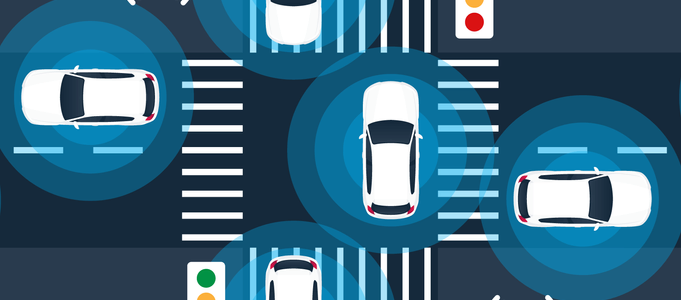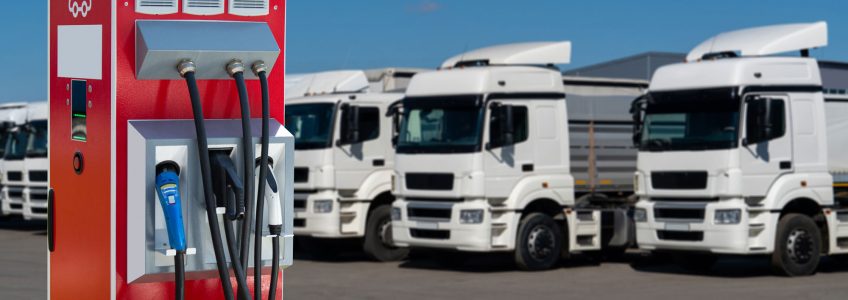Connected Cars: A World of Possibilities for Enhanced Vehicle Performance
All over the world, businesses, governments and individuals are equipping their vehicles with internet connection, while the top auto manufacturers are embedding telematics devices in their newest models, making these the most game-changing smart device in recent years.
A connected car is a vehicle that is equipped with mobile technology, and therefore “connected” via the internet. Telematics is also used to connect cars, by means of a small device that plugs into the vehicle, or through embedded technology. The telematics device acts as an Internet of Things (IoT) hub which sends vehicle data to a cloud service, where it can be processed and 5G will speed up connected car benefits.
Fifth Generation of Wireless Technology
The introduction of 5G promises to improve the speed and reliability of mobile internet connection. At its peak, 5G operates 100 times faster than 4G and has extremely low latency. This means 5G devices can download and send vast amounts of data in a fraction of the time it would take using 4G.
5G is expected to grow the market for the ever-increasing number of tools, whether smartphones or thermostats, that rely on stable internet connection. One such tool, a connected car, generates millions of data points each day, which can be transferred faster than ever using 5G. Real-time tracking will become even more accurate, improving solutions like Advanced Driver Assistance Systems which help drivers avoid collision hazards.
OEM Telematics
A trend is emerging among leading vehicle manufacturers — or Original Equipment Manufacturers (OEMs) — to embed telematics devices directly into new vehicle models. Embedded devices are capable of processing OEM-specific vehicle information and telematics data once the consumer has given consent to the manufacturer. This data can then be integrated with an online fleet management platform that standardizes the user experience, enabling owners of fleets with a variety of vehicle and connectivity types to see all vehicle information in one place.
Connected Vehicle Technology and Applications
Once vehicles are connected, rich GPS and on-board diagnostics (OBD) data can be processed and presented on an online fleet management platform. Fleet managers can use this information to make critical business decisions, measure the effectiveness of those decisions and benchmark performance against similar fleets.
Here are a few ways fleets can benefit from connected vehicle technology:
-
Productivity: Track factors that influence fleet productivity, such as idling time, driving time, customer visits or ignition locations.
-
Safety: Detect risky driving behavior such as harsh braking, speeding or sharp cornering. Set up driver coaching and advanced driver assistance, or install dash-cam solutions to gain visibility into on-road activity.
-
Maintenance: Access vehicle health data. Use a connected fleet management platform to set up predictive maintenance to minimize the risk of unexpected, and potentially dangerous, vehicle failure.
-
Sustainability: Get precise data on fuel usage and inefficient activities like idling. Fleets made up of EVs, or a mix of EVs and conventional vehicles, can monitor charge levels, range and battery degradation.
How connected vehicle technology is changing the fleet industry
Today’s capabilities, such as those offered by Advantage Asset Tracking, go far beyond providing location information. Connected fleet managers can easily view and monitor variables like driver behavior, fuel usage, harsh events and engine health. This information can be used to construct comprehensive plans for improving fleet safety, productivity, sustainability and more.
Get More Mileage Out of Your Government Fleet With Geotab Keyless
Many government agencies may currently have larger than needed fleets. This means they have more vehicles than needed resulting in massive underutilization and unnecessary increased costs associated with maintaining those assets.
In any organization, it is important to utilize all assets as efficiently and effectively as possible. This is sometimes difficult with motorpools. Here’s why:
-
TCO — The total cost of ownership becomes very high, especially when all vehicles are not being used in the same way and potentially sitting in parking lots not being used.
-
Key management — Organizations must plan manual and physical ways to coordinate key drop-off and pick-ups, which becomes increasingly difficult during times such as the COVID-19 pandemic.
-
Billing and paperwork — When motorpools are shared between different departments, it increases manual billings and paperwork which can become time consuming for everyone involved.
-
Sustainability — Fleets with excessive vehicles have a larger carbon footprint. This works against state, local, federal or provincial sustainability mandates for reducing the use of combustion engine vehicles or decreasing carbon emissions.
-
Increased costs — There is an increase in costs including annual maintenance and labor, such as having to jumpstart a vehicle with a dead battery because of underutilization.
What’s a solution? Introducing Geotab Keyless: a digital key solution to help maximize motorpool utilization, providing a seamless car sharing experience and reduction in costs. Below are a few benefits of using this digital key solution.
1. Geotab Keyless is a secured and keyless access
Geotab Keyless eliminates the need for physical keys and helps organizations ensure only authorized employees have access to vehicles.
2. Improved utilization and aid in rightsizing your fleet
Get complete fleet visibility to reduce, repurpose or redistribute assets to increase utilization. With more drivers sharing one car, you can grow carsharing without growing the number of vehicles. Plus, Keyless makes it easier to prioritize vehicles with the lowest miles to maximize usage.
3. Seamless car sharing operations
Geotab Keyless makes it easy to share vehicles between departments in a government agency. Additionally, you can digitize billings with integrated software to reduce overall paperwork.
4. Reduce costs and save time
No staff is needed to physically manage keys or replace lost keys which will lead to a reduction in costs and save time.
5. Meet sustainability goals
With all vehicles being properly utilized, agencies can work toward achieving their sustainability goals.
Integrating telematics with Geotab Keyless
For government agencies, having the power of a telematics platform alongside secured keyless technology provides fleets with a safer way to control and manage day-to-day operations.
Geotab Keyless supports all vehicles that have a keyfob including electric, hybrid, Light-Medium and Heavy-Duty vehicles. It is easy to install and users also have the flexibility to use the application with a mobile app or NFC tags along with the ability to operate a free-floating or centrally located motorpool operation.
Sign up for a demo
Whether you are new to motorpools, or want to rightsize your fleet, explore the solution first-hand and sign up here to learn more. For more information or additional inquiries about Geotab Keyless, please email info@advtracking.net
Five Electric Commercial Truck Companies We are Keeping an Eye on in 2021
A number of startups and automotive giants have been busily working to electrify delivery and distribution trucks in the coming years: all-electric heavy-duty big rigs, semi-trucks, box trucks, delivery vans and more. While the major obstacles facing the electrification of the automotive industry are ones of scale, price points, battery technology, and charging station accessibility, advancements expected over the next 10 years will lead to more electric vehicles driving alongside or even replacing the diesel- and gas-powered trucks and vans that America relies on to carry goods (and people) across the country.
Here are five major players we are keeping an eye on in 2021.
BYD
Unlike other companies looking to disrupt the long-haul trucking industry, BYD is eyeing the short-haul goods movement sector, primarily in America’s ports, rail yards and freight-handling facilities. In 2020, it rolled out more of its battery-electric trucks to customers across the United States.
BYD’s Class 8 Day Cab has a range of 125 miles and a top speed of 65 miles per hour. The truck’s battery packs can recharge in as little as two hours with a high-speed direct current system or about 14 hours with a standard 240-volt charging system.
The company’s trucking division says its medium- and heavy-duty electric trucks are making up an increasing part of the company’s U.S. operations.
Chanje
One company aiming to electrify the package delivery industry is a Los Angeles-based, Chinese-backed startup called Chanje.
The company’s nearly 30-foot long V8100 electric medium-duty panel van can carry a 3-ton payload. What’s more, the van’s lithium-ion battery pack holds enough charge for a 150-mile range. According to the company, that’s more than double the number of miles the majority of commercial delivery vans drive in a day.
Daimler Trucks
In 2018, German automaker Daimler, the largest truck maker in the world, announced its all-electric 18-wheeler: the Freightliner eCascadia.
The big rig has a 250-mile range and was designed for regional transportation and port service. Daimler’s other all-electric model, the Freightliner eM2 106, has a 230-mile range and is intended for more local distribution and deliveries. Both the eCascadia and eM2 are currently planned to enter series production in late 2021. The company also has an all-electric box truck (for urban deliveries) and a school bus in the pipeline.
Nikola Motors
Few are likely to be familiar with the Phoenix-based startup that got the naming rights to Tesla’s first name. However, over the past five years, Nikola Motor Co. has slowly but surely emerged as a pioneer in this space.
The company has created the Nikola Two and the Nikola Tre for both European and North American markets. Each semi-truck is available with hydrogen fuel cell electric capabilities and their anticipated ranges are between 250 and 750 miles.
Lion
While the medium and urban truck markets are already getting attention from multiple truck manufacturers and a few startups, in the uncrowded school bus market there are only Lion Electric, Blue Bird, IC Bus, a division of Navistar, and Thomas Built, the division of Daimler Trucks/Freightliner.
Lion Electric has been around since 2008 and currently has an annual capacity to produce 2,500 trucks and buses per year. In addition to school buses, Lion Electric manufactures medium box and urban trucks, and specialty trucks such as garbage haulers. The usage profile for these trucks usually involves lower mileage per day and periods of overnight storage, lending themselves to excellent opportunities for electrification. Amazon is onboard with the opportunity to buy 2,500 Lion urban trucks and to potentially own 20% of the company.
For those considering converting all or part of their fleets to EVs, Advantage Asset Tracking has your entire fleet solutions roadmap covered backed by the worlds leading telematics provider, Geotab.
Our knowledgeable team will guide you through the entire selection process to ensure you make the right choice for your business!
Geotab announces release of upgraded GO9+ telematics device
GO9+ adds high-speed wireless to its flagship telematics solution to support fleet operations and burgeoning consumer connectivity. The new GO9+ is built upon Geotab’s GO9 device. Released in 2019, this device was designed to help businesses better manage their fleets through improved acceleration tracking, a more accurate GPS and better support for vehicle-generated data and for new vehicle types.
The newly added connectivity of GO9+ will allow businesses full visibility of their vehicles in real-time, as well as offering Wi-Fi connectivity for up to four hours with the ignition off, thereby eliminating wasted fuel and greenhouse gas generated when idling for WiFi access.
The GO9+ is ideal for fleets and vehicles of all classes and duties, including heavy truck fleets, rideshare vehicles, small business fleets, ride-for-hire services, buses and even for use as a single-vehicle mobile office. As with all Geotab devices, it is supported by the MyGeotab platform, which provides managers with centralized access to all connected vehicle data.
Just as the GO9+ is an essential tool for any business operating with vehicles in the field, with the addition of Wi-Fi, GO9+ saves cost by reducing the number of cellular connections in the field while improving access to data options for employees.
-
Field workers can safely receive work orders, email and other correspondence while in the field — without the need to leave their vehicles
-
Ideal solution for ride sharing, buses and limousines to give customers the ability to stream music, work on a project or connect with others effortlessly while they ride to their destination
-
Continuous Wi-Fi signal for up to four hours even when the vehicle is off
-
Long-haul drivers can take advantage of high-speed wireless connectivity while in their truck cabs off hours — without the need to tap personal cellular data plans
-
Ideal for fleets that need to upgrade their devices in advance of the 3G shutdown and subsequent device migration coming in 2022
Here’s Geotab’s CEO, Neil Cawse discussing how the GO9 platform is paving the way for future GO devices.
The GO9+ will first be available in the United States. The telematics solution is expected to roll out in other regions in 2021. For more information on GO9+, visit: https://www.advtracking.net/vehicle-tracking
5 Challenges and Solutions Facing Winter Road Works
Winter operations can be challenging for existing and new businesses. If a company does not understand or prepare for the level of compliance required for winter work, it can only make matters worse. Being caught unprepared in this area can disappoint customers and lead to a number of other problems.
Here are five common issues that arise when managing winter road compliance and ways to solve them:
Challenge 1: Managing busy shifts
Nature is rarely accommodating. Snow and ice can appear overnight, causing dramatic shifts in workloads. Being able to manage your employees under changing or surprising weather conditions is an important part of running winter operations.
Solution: Operation managers are responsible for tracking their organization’s workload, so stay organized! Many companies use spreadsheets or software to track serviced and unserviced areas and efficiently dispatch employees. Organization is key because it allows a business to fulfill service obligations in an efficient manner.
Challange 2: Hitting contract targets
Most municipalities have specific standards for winter maintenance and reflect those standards in service level agreements. For example, the City of Ottawa in Canada allows four hours for clearing after the end. Maintenance crews are given 16 hours to clear residential roads and lanes.
Solution: Just like managing busy shifts, businesses need to stay organized in order to hit their contractual obligations.
Challenge 3: Choosing the right equipment
Even the most organized winter maintenance operation can’t finish the job without the right tools and vehicles to support their workers. One of the biggest mistakes businesses make is underspending and leaving themselves open to failure when the unexpected happens. A truck might break during a job but you still have to honour your customer agreements.
Solution: Prepare in advance by investing in back-ups and spares. Keeping vehicles up-to-date on maintenance and fuel is also essential. After all, prevention is the best cure.
Challenge 4: Top-of-the-line customer service
Don’t keep customers in the dark. Keep the expectations of customers and clients in mind at all times.
Solution: Do research and be aware of the different ways your company can connect to customers and keep them informed about project statuses. Twitter updates or online portals are two small ways to keep the public informed of your work to let them know when the roadways are safe and clear.
Challenge 5: Maintaining accurate records
Accurate record keeping eases many logistical challenges and also helps mitigate liability risks. Companies engaged in winter maintenance are especially vulnerable to litigation due to contracted terms, compliance issues and the slip-and-fall hazards present on job sites.
Solution: Successful winter maintenance businesses keep a spreadsheet or use software to record all of their jobs. Recording elements like job time, employee responsibilities, vehicle locations and salt dispensed can ensure any issues can be quickly resolved with timely and accurate information. Records also provide an important back up if needed.
This 2021 winter businesses wield great revenue-generating power but in order to justify that power, they must take responsibility to overcome common winter compliance issues. Always remember, the most important part of any business is always working hard and staying true and honest to your employees and clients.
For more details on ways Advantage Asset Tracking builds and manages integration and application development for fleet and field service companies contact us at info@advtracking.net






